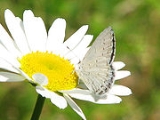
Celastrina neglecta
Encyclopedia
The Summer Azure is a butterfly
of the Lycaenidae
family. It is found in North America
. Layberry, Hall and Lafontaine, in The Butterflies of Canada, describe the species:
Wingspan
is 23 to 29 mm (15/16 to 11/8 in).
The Summer Azure occurs across most of eastern and central United States as well as southern Canada from Nova Scotia
to southern Saskatchewan. Adults fly from mid-June until early October with two or three generations in the south.
In their monograph on the Lycaenopsis group of Polyommatine genera, Eliot & Kawazoe considered Lycaena neglecta Edwards, 1862, to be a synonym of Lycaena lucia Kirby, 1837, which they listed as subspecies Celastrina argiolus lucia. Thus the according here of specific status to neglecta is of doubtful authenticity.
Butterfly
A butterfly is a mainly day-flying insect of the order Lepidoptera, which includes the butterflies and moths. Like other holometabolous insects, the butterfly's life cycle consists of four parts: egg, larva, pupa and adult. Most species are diurnal. Butterflies have large, often brightly coloured...
of the Lycaenidae
Lycaenidae
The Lycaenidae are the second-largest family of butterflies, with about 6000 species worldwide, whose members are also called gossamer-winged butterflies...
family. It is found in North America
North America
North America is a continent wholly within the Northern Hemisphere and almost wholly within the Western Hemisphere. It is also considered a northern subcontinent of the Americas...
. Layberry, Hall and Lafontaine, in The Butterflies of Canada, describe the species:
The upper surface is pale blue with an extensive dusting of white scales, especially on the hindwing. In some females the blue is almost entirely replaced by white with a small amount of blue near the wing bases. Females have a broad blackish-grey band on the outer third and costa of the forewing. The underside is chalky white to pale grey with tiny dark grey spots and a zigzagged submarginal line on the hindwing.
Wingspan
Wingspan
The wingspan of an airplane or a bird, is the distance from one wingtip to the other wingtip. For example, the Boeing 777 has a wingspan of about ; and a Wandering Albatross caught in 1965 had a wingspan of , the official record for a living bird.The term wingspan, more technically extent, is...
is 23 to 29 mm (15/16 to 11/8 in).
The Summer Azure occurs across most of eastern and central United States as well as southern Canada from Nova Scotia
Nova Scotia
Nova Scotia is one of Canada's three Maritime provinces and is the most populous province in Atlantic Canada. The name of the province is Latin for "New Scotland," but "Nova Scotia" is the recognized, English-language name of the province. The provincial capital is Halifax. Nova Scotia is the...
to southern Saskatchewan. Adults fly from mid-June until early October with two or three generations in the south.
In their monograph on the Lycaenopsis group of Polyommatine genera, Eliot & Kawazoe considered Lycaena neglecta Edwards, 1862, to be a synonym of Lycaena lucia Kirby, 1837, which they listed as subspecies Celastrina argiolus lucia. Thus the according here of specific status to neglecta is of doubtful authenticity.

